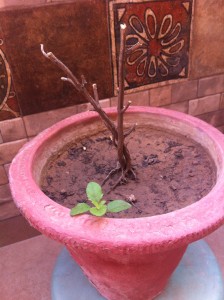Hare Krishna.
28th November, 2016. Gurgaon
Tulasi
We can understand how pure is the service which Tulasi offers to Sri Krsna. So we should always endeavor after becoming the servant of Tulasi devi. I do not know who has taught you that part of a Tulasi plant may be cut off and then replanted? From the Tulasi plant you can cut off only leaves for offering them to Krsna, never for cutting and planting. That is an offence. The manjaris (seeds) can be offered in water and it makes the water fragrant and tasteful. And the manjaris can be planted for growing new Tulasi plants. Yes, the prayer you have enclosed is bona fide. Tulasi devi never goes back to Godhead, she is always with Godhead. She is a pure devotee and thus she has appeared on this planet to render service to Krsna by being offered in all temples throughout the world by being offered up to the lotus feet of Krsna.”
(SPL to Radhaballabha dasa, January 6th, 1972)
There are few things as heart breaking as when a devotee’s Tulasi plant dries up. As the winter approaches in India, we should be more careful in our service towards Tulasi. We can take some basic precautions
- Making sure that she is not left out in the hard winter of North India. Try keep her under some shade, so she does not get too cold dew falling on her, or build a temporary shade for winter.
- We can bring her inside the house in the night, if making a shade is not practical for some of us. In that case please bring her outside during day time to get some sunlight.
- Please water her carefully, not too much (leaves turn black) or too less. Please keep a sharp eye on the soil and water accordingly,
- It is a good practice to give her a mild bath on a sunny afternoon. We can mix a little natural soap (free from animal fat) in water and spray on her leaves. After an hour or so we can spray normal water and we will immediately see the difference on her leaves. This also prevents breeding of insects on her leaves.
- In case we see insects breed under her leaves then we can mix pure neem oil (8-10 drops in 500ml water) with the soap, as described above, Spray fresh water after 1-2 hours.
- Besides daily singing her pranam mantra and arti, it might be a good practice to pray to her daily to remain healthy, seeking forgiveness for all the offenses we might be committing in her daily service and still requesting her to kindly inspire in our heart how to serve her best.
I’m copying some questions a devotee asked Srila Prabhupada on Tulasi and his answers via letter in 1965.
- Q: Is each Tulasi a separate jiva soul or an expansion of one pure devotee?
- A: Tulasi is one devotee who appears wherever there is devotion to Kåñëa.
- Q: Where does her spirit soul go when she leaves this body?
- A: Tulasi’s body is spiritual.
- Q: When tulasi is being cared for by householders in their homes, must two aratis still be offered?
- A: If possible
- Q: When tulasi is being cared for by householders in their homes, may they use her leaves and manjaris on their home offerings or should they take them to the temple?
- A: Tulasi leaves should be offered to the Deity.
- Q: When tulasi is being offered arati by the householders, must she have a ghee lamp?
- A: If possible
- Q: Is it offensive to turn the baby tulasis back into the soil when they appear?
- A: Yes
- Q: There are even questions concerning tulasi’s aratis. We have always offered her incense, ghee lamp, and a flower. Is this correct?
- A: Yes
- Q: In the manual, it states that tulasi should not be pruned. Does this mean trimming the branches which no longer have leaves or life fluids flowing through them?
- A: You may cut the dead branches, but what is the necessity?
- Q: We were told you once spoke the “four regulative principles of tulasi care” which will keep her from getting sick: (a) keep her moist; (b) keep her clean; (c) give her morning sunlight (at least); (d) give her two aratis a day. Is this bona fide?
- A: I never said that
- Q: May tulasi be made into a tea after she has been offered?
- A: No
- Q: May devotees carve tulasi wood for Deity paraphernalia?
- A: Yes
- Q: When tulasi leaves her body and the body is too soft for carving beads, how should she be used? Should a small fire sacrifice be performed?
- A: Use the wood for beads as far as possible, the balance may be placed within the earth.
- Q: We have a letter from you requesting that no sprays be used on Tulasi-devé . May we use a spray of buttermilk and whole wheat flour dissolved in water which coats her leaves to keep spider mites from causing tulasi to leave her body?
- A: I said no chemical sprays
- Q: Does tulasi sleep? Should she be left undisturbed after nightfall?
- A: Undisturbed means what?
- Q: Is it permissible to use scissors to cut her manjaris, and when transplanting, to use knives to loosen her from her pot?
- A: Use common sense and if you have none then consult with others
- Q: Is it an offense to step on or across her shadow (or the shadow of any pure devotee)?
- A: No
- Q: For two years we have been waiting permission to use the following two prayers plus translations and a translation of the already existing prayer. Please tell us if these are bona fide. (I haven’t copied them here)
- A: Don’t try to introduce something new. The most important thing is the love and devotion.
HH Satsvarupa Maharaj commented as below on the above Q & A in his book Srila Prabhupada Nectar.
Devotees will probably always continue to inquire how they may increase or improve the performance of Deity worship and their other service activities. Prabhupäda gives some important guidelines here when he writes, “Don’t try to introduce something new. The most important thing is the love and devotion.” Not simply by adding more mantras and more paraphernalia do we increase the standard of devotion. At the same time, Prabhupäda gradually introduced more of the temple activities as time went by and he saw that the devotees were able to do it. As far as possible, we should try to gather Prabhupäda’s authoritative instructions and follow them, such as this valuable collection of advice about tulasé worship.
Vidyä-devé däsé was impelled by her devotion to tulasé to ask Prabhupäda many questions about her worship, but Prabhupäda, by his short replies, reminds us that even on a practical basis, tulasé is kept alive and well by the love and devotion of her worshipers. That is the main ingredient.
Pundarika: I remember one time I was in Mayapur in 1976 and was serving as a pujari. One day I was collecting tulasi manjaris from the tulasi plants that grew around the temple. All of a sudden Prabhupada’s servant yelled down, “Pundarika, come upstairs. Srila Prabhupada wants to talk to you. Come right now.” When I got there Prabhupada told me, “Never touch tulasi with a knife.” I had been cutting the tulasi manjaris with scissors and Prabhupada said, “Never touch tulasi with a knife.” So I learned to pick by hand the tulasi manjaris and not a knife.
( Srila Prabhupada rememberances- Sidhanta dasa)
I am copying links to some websites which might help those devotees who may wish to know in more detail on how to serve Tulasi properly. As climate and soil varies from each location, my strong advice will be to first cross check, whatever we may read and feel inspired to apply, with the local temple/ devotees.
http://www.deityworship.com/worship/worshipping-tulasi-devi/cultivation-care-of-tulasi-devi
https://iskconklang.wordpress.com/2008/08/08/tulasi-tips-from-iskcon-vancover
http://www.stephen-knapp.com/tulasi_devi_handbook.htm
http://www.harekrsna.com/practice/sadhana/morning/tulasi-arati/care.htm
Below is a link to various seminar and glorification of Tulasi by senior devotees.
Seminars on Tulasi and other pastimes
We should be clear in our consciousness that Tulasi is not merely a Holy plant but that she is personality and as an aspiring devotee it is in our best interest to build a relationship with her, serving her with Love and Devotion is first step in that direction. Tulasi devi has manifested in this world to render service to Krishna, and not to us, and as aspiring servant of the servants, it will do us much good to serve her in best possible manner.
So I am very glad that you are seriously interested, and Kåñëa is pleased upon you. And that you are sincerely trying, I can understand from these tulasé plants. Yes. This is the practical demonstration. Unless there is bhakti, this tulasé plant will not grow. We must be very much thankful to our Govinda däsé. She first of all cultivated the tulasé plant in Hawaii. And now our tulasé plants are distributed. So she has done a great service. I think I gave her the seeds, and she very nicely done it. Now everywhere we see tulasé plant. It is very pleasing. So the same thing—Deity worship and watering the tulasé plants, chanting sixteen rounds at least, and observing the rules and regulation, regulative principle… Then your life is successful. Don’t neglect. Very seriously continue. And in this one life you are going back to home, back to Godhead. It is sure. I am not flattering you. Kåñëa says, man-manä bhava mad-bhakto mad-yäjé mäà namaskuru, mäm evaiñyasi asaàçayaù [Bg. 18.68]. Asaàçayaù, “Without any doubt, simply following these rules and regulation,” mäm evaiñyasi, “you come back to Me.”
( SPL 1st August, 1975, New Orleans Farm)
All glories to Tulasi Maharani.
All glories to Sri Guru and Gauranga.
All glories to Srila Prabhupada.




